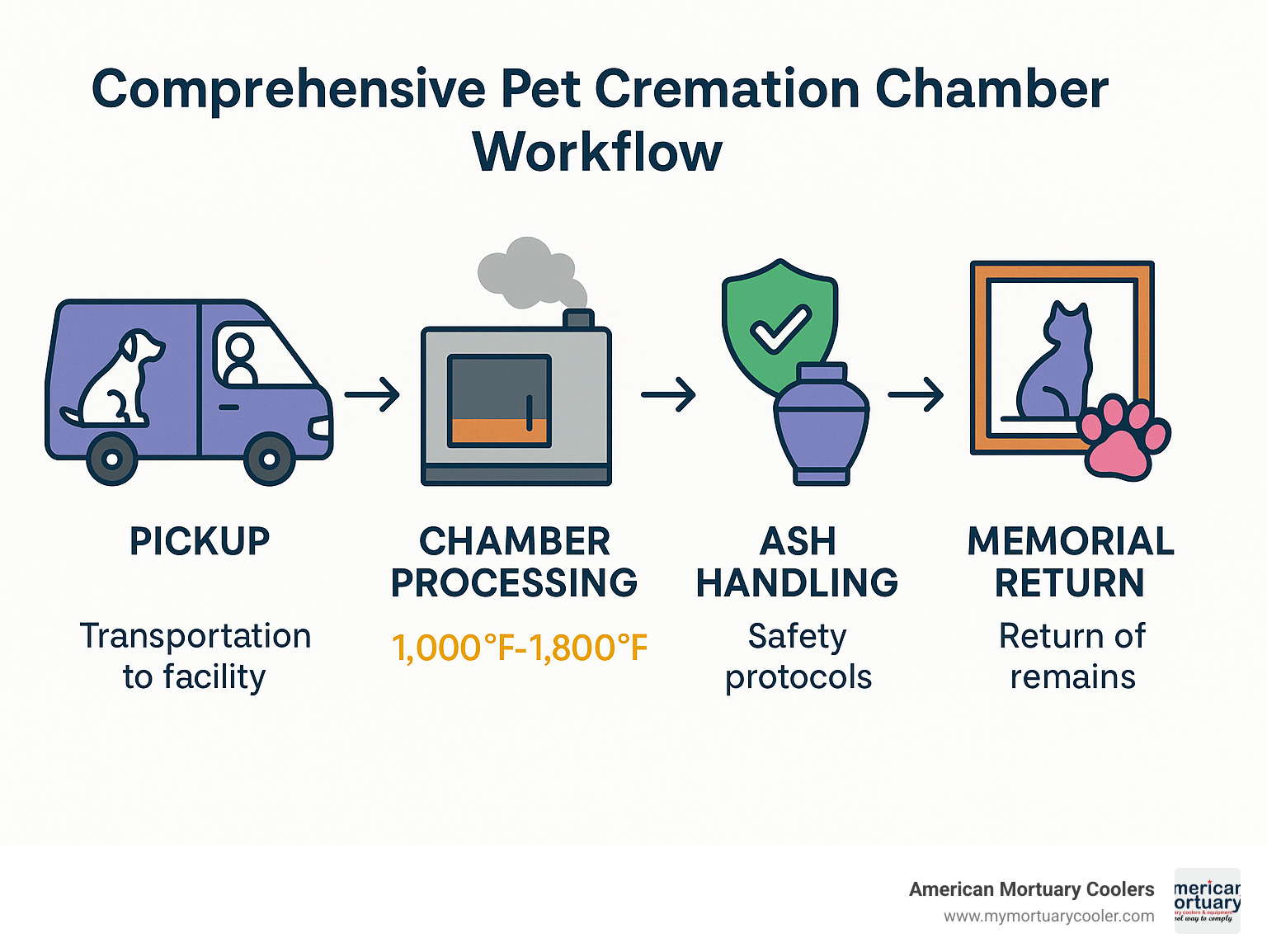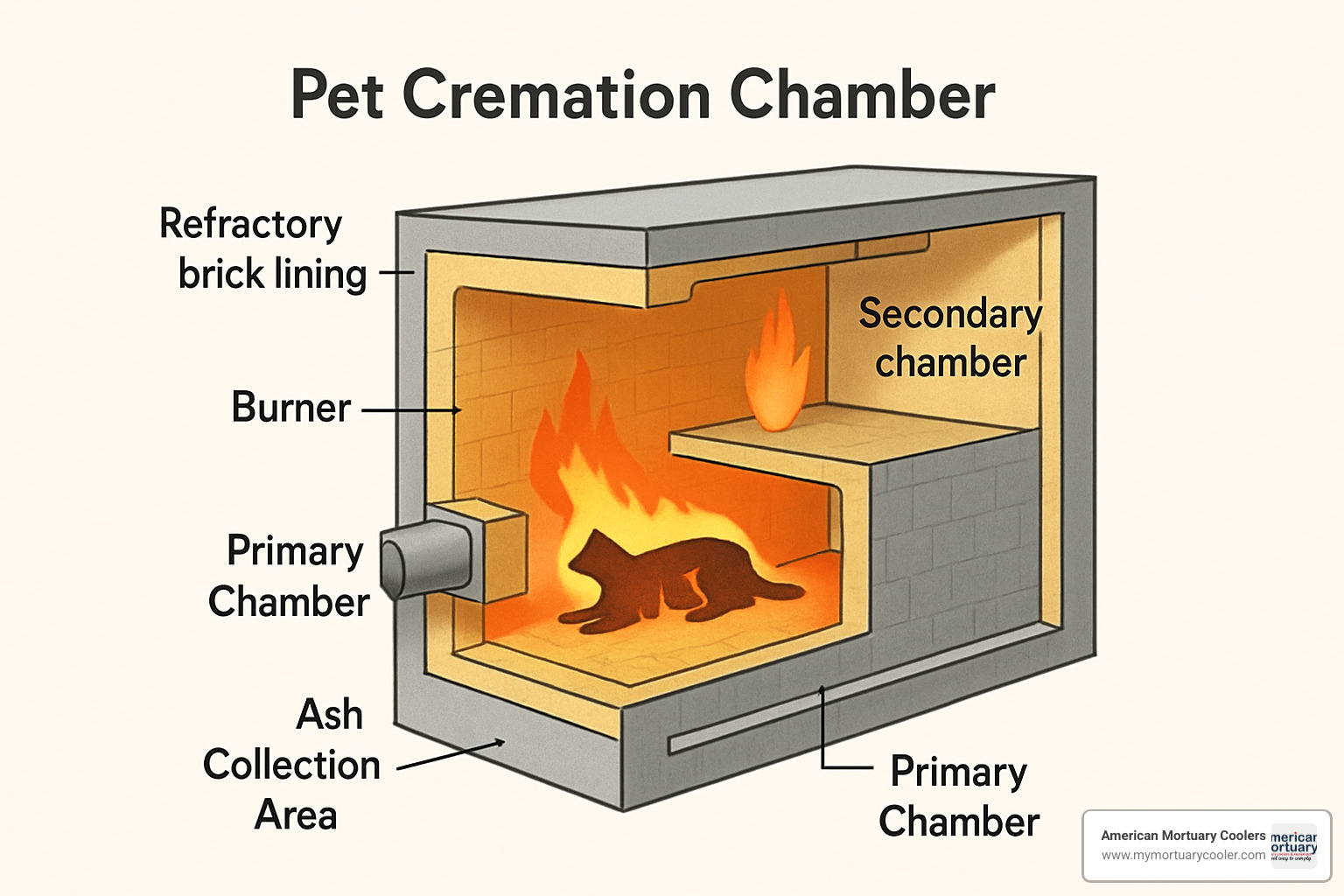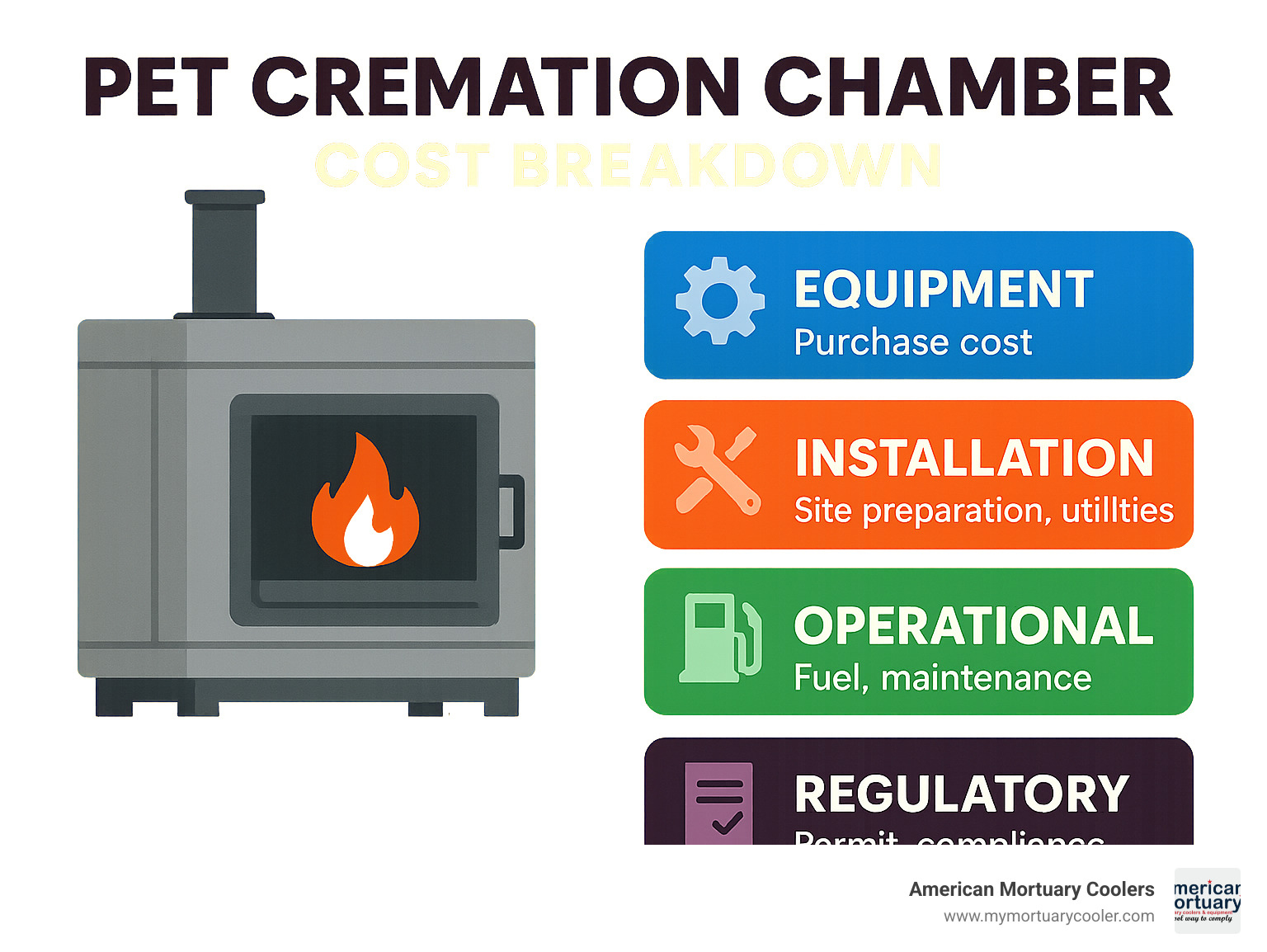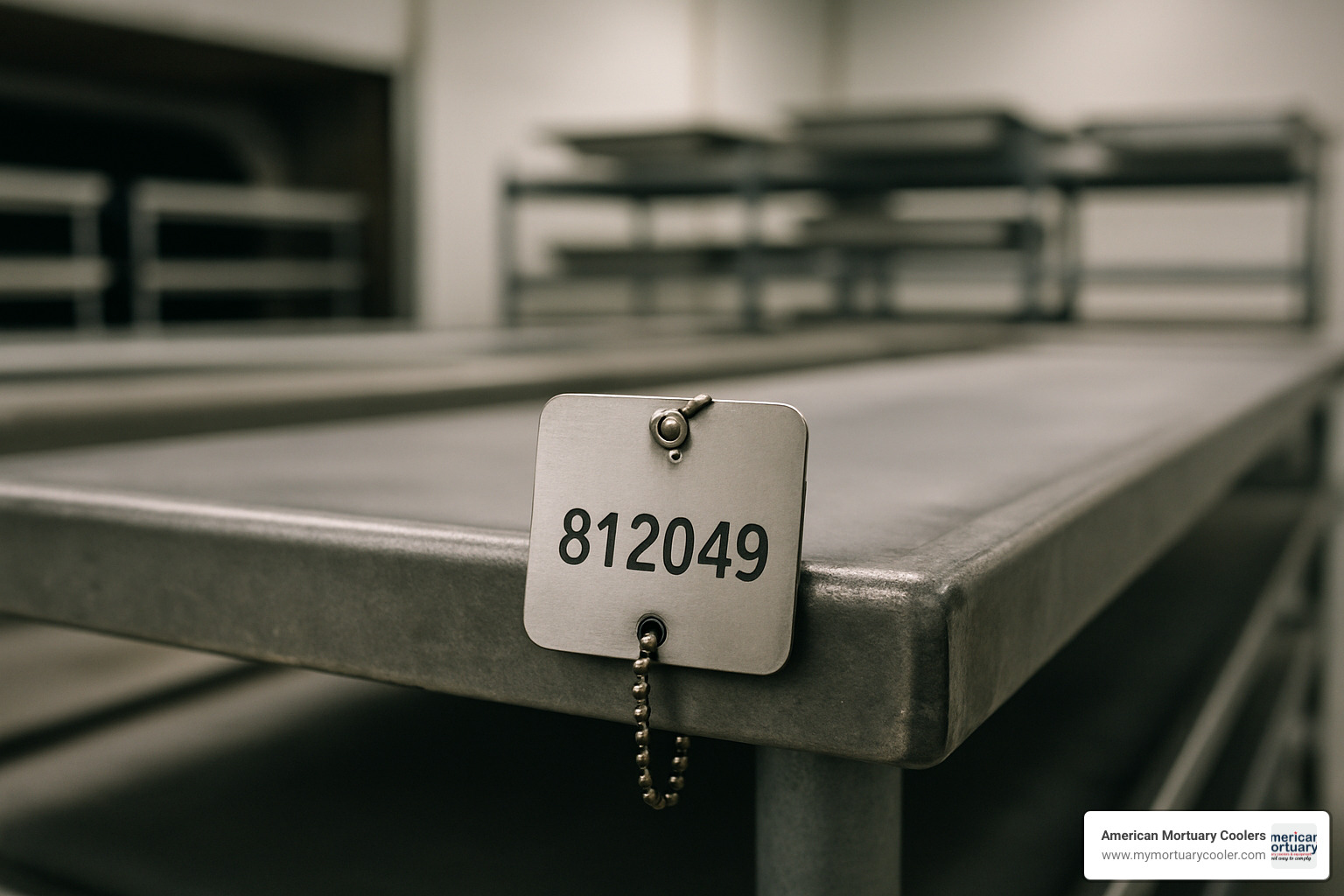Why Pet Cremation Chambers Are Essential for Modern Pet Care Facilities
A pet cremation chamber is a specialized high-temperature furnace designed to respectfully process animal remains, operating between 1,000°F-1,800°F to ensure complete combustion while maintaining dignity throughout the process.
Key Pet Cremation Chamber Facts:
- Types: Single-chamber, multi-chamber, and equine units
- Capacity: From 75 lbs/hour to 450+ lbs/hour throughput
- Temperature: Primary chamber 1,000°F-1,200°F, secondary 1,600°F-1,800°F
- Cremation Options: Private, partitioned, or communal processing
- Typical Cycle: 2-5 business days for private cremations
- Cost Range: $135-$370+ based on pet weight
The pet memorial industry has grown dramatically as more families choose cremation over burial. Pet cremation offers a dignified, eco-friendly alternative that provides closure while being more practical than traditional burial methods. Modern pet cremation chambers use advanced technology like PLC automation, emission controls, and multi-chamber designs to handle up to 60+ individual cremations daily.
As Matthews Pet Cremation Systems notes: "From low-volume individual cremators to massive, large-animal units suitable for equine or bovine use, Matthews animal cremators offer solutions for every type of crematory."
I'm Mortuary Cooler, a national-level mortuary cooler supplier with extensive experience helping funeral homes and veterinary facilities select the right equipment for their needs. My background in mortuary equipment has given me deep insight into how pet cremation chamber technology integrates with broader facility operations to serve grieving families.

Glossary for pet cremation chamber:
Understanding the Pet Cremation Chamber: Anatomy, Temperatures, Materials

Think of a pet cremation chamber as a carefully engineered tribute to your beloved companion. These aren't just industrial furnaces - they're sophisticated systems designed with both respect and precision in mind.
The heart of any cremation chamber lies in its construction materials. Refractory bricks line the interior, capable of withstanding temperatures up to 3,000°F, though most operations run between 1,000°F and 1,800°F. These specialized bricks are engineered to handle repeated heating and cooling cycles while maintaining structural integrity.
Surrounding this fire-resistant core is a heavy-gauge stainless steel shell with powder-coat finishes. This outer layer provides durability while making daily maintenance manageable for busy facilities.
Modern chambers use a dual-chamber design that's become the industry standard. The primary chamber handles initial combustion at 1,000°F-1,200°F, while the secondary chamber operates at 1,600°F-1,800°F. This two-stage process ensures complete combustion while meeting strict environmental regulations.
The fuel system typically runs on natural gas or propane, with sophisticated burners that modulate fuel and air continuously. Advanced units include PLC (programmable logic control) systems that automate the entire process, removing guesswork and ensuring consistent, respectful results every time.
The exhaust system includes refractory-lined emission stacks and inducers that handle byproducts safely. Many facilities also include ash processors that create the fine, consistent cremated remains families expect to receive.
What Does a Pet Cremation Chamber Look Like Inside?
Step inside a pet cremation chamber and you'll see engineering designed with purpose. The interior combines industrial strength with thoughtful details that honor the process.
Fire-brick lining covers every interior surface, creating a durable workspace that can handle thousands of cremation cycles. The hearth floor uses specially designed refractory materials that distribute heat evenly while making cleaning between services straightforward.
Temperature probes are strategically placed throughout the chamber, constantly monitoring conditions and feeding data to the control system. These ensure each cremation meets the exact standards your families deserve.
Multiple insulation layers surround the combustion area. Ceramic fiber insulation provides superior heat retention while keeping external surfaces at safe temperatures. This insulation is crucial for both energy efficiency and operator safety during daily operations.
Most chambers include an observation port with heat-resistant glass. This allows operators to monitor the process without opening the main door - essential for maintaining proper conditions and troubleshooting when needed.
The loading area features hydraulic or manual doors with heavy-duty hinges and sealing mechanisms. Interior dimensions vary significantly based on your needs, from compact units perfect for small animal practices to large chambers capable of handling equine remains.
How a Pet Cremation Chamber Works Step-by-Step
The cremation process in a pet cremation chamber follows a carefully orchestrated sequence that ensures dignity and completeness at every stage.
Pre-heating begins the process, with the chamber reaching operating temperature over 30-60 minutes. The PLC system handles this automatically, monitoring conditions and making adjustments as needed.
During loading, your pet is respectfully placed in the primary chamber. Many facilities use hydraulic lift tables for larger animals, and unique identification tags ensure proper tracking throughout the entire process.
Primary combustion occurs at 1,000°F-1,200°F with carefully controlled airflow. This phase typically runs 60-90 minutes depending on your pet's size, with the system maintaining optimal conditions automatically.
Secondary afterburn is where complete combustion occurs. Gases and particles from primary combustion pass to the secondary chamber operating at 1,600°F-1,800°F. This ensures complete combustion and minimizes emissions, with retention times exceeding one to two seconds - well beyond regulatory requirements.
Cool-down follows completion, with the chamber gradually returning to safe temperatures while maintaining proper ventilation. This phase takes several hours and protects both equipment and operators.
Ash processing transforms remaining bone fragments into the fine, consistent cremated remains using specialized equipment. This final step ensures families receive a respectful final product.
The cleaning cycle between cremations maintains sanitary conditions and prevents any cross-contamination, ensuring each family receives only their beloved companion's remains.
Types, Sizes & Capacities of Pet Cremation Chambers
When it comes to choosing a pet cremation chamber, you'll find the market offers several thoughtful configurations designed to meet different needs and volumes. Think of it like choosing the right kitchen for a restaurant - the size and setup need to match your daily operations perfectly.
Single-chamber systems are the gold standard for complete privacy, handling one beloved pet at a time. These units typically process between 75 to 400 pounds per hour, with load capacities ranging from 300 to 1,200 pounds. They're perfect for smaller veterinary practices or facilities where families want that extra assurance of individual care. There's something deeply respectful about knowing your pet has the chamber entirely to themselves.
Multi-chamber systems offer an neat solution for busy facilities that still want to maintain complete separation. Take the S-18 P6 Multi-Chamber Pet Cremator, for example - it can handle up to 450 pounds per hour across six separate chambers, with each chamber safely accommodating up to 150 pounds. This means you can process multiple pets simultaneously while ensuring each family receives only their pet's remains. It's efficiency with dignity intact.
For our larger animal friends, equine units are specially engineered chambers that can handle horses and livestock up to 2,000 pounds. These substantial units are essential for veterinary hospitals serving farms and equestrian facilities. The engineering required for these systems is quite impressive - they maintain the same respectful standards while handling significantly larger loads.
The choice between hot-hearth and cold-hearth models affects how your facility operates day-to-day. Hot-hearth systems keep some heat between cremations, which reduces cycle times and saves on fuel costs. Cold-hearth models cool completely between uses, which some operators prefer for their specific protocols or safety requirements.
Modular expansion capability is available in some systems, allowing your facility to grow organically. This scalability is particularly valuable for practices that expect to expand their services over time - you can start with what you need today and add chambers as your business develops.
| System Type | Load Limit | Pets/Day | Burn Rate | Footprint | Ideal Users |
|---|---|---|---|---|---|
| Single Chamber | 300-1,200 lbs | 5-15 | 75-400 lbs/hr | Compact | Small clinics, private services |
| Multi-Chamber | 150 lbs/chamber | 30-60+ | 450+ lbs/hr | Large | High-volume facilities |
| Equine | 2,000+ lbs | 2-5 | Variable | Very Large | Large animal hospitals |
Choosing the Right Pet Cremation Chamber for Your Volume
Selecting the right pet cremation chamber is like finding the perfect fit - it needs to match your current reality while leaving room for growth. The most important factor is your daily throughput. If you're processing fewer than 10 pets daily, a single-chamber unit will likely serve you well. But if you're handling 30 or more pets regularly, you'll want to look at multi-chamber systems.
Weight classes play a crucial role in your decision. The KMA 1200-75 is designed for pets up to 75 pounds, making it ideal for small animal practices focused on cats and smaller dogs. Larger facilities often need something like the KMA 1200-400, which offers 400 pounds per hour burn rates and 1,200 pounds total capacity - perfect for handling multiple large dogs or even small horses.
Future scalability deserves serious consideration in your planning. The pet memorial industry continues growing, and your facility's needs may expand faster than you expect. Some manufacturers offer expandable systems that let you add chambers as your business develops, protecting your initial investment while providing flexibility for the future.
Facility footprint often becomes the deciding factor, especially for existing buildings. Multi-chamber systems require substantial space - for instance, the S-18 P6 measures 29 feet by 6 feet 9 inches by 10 feet 6 inches and weighs nearly 40,000 pounds. You'll need to ensure your facility can accommodate not just the equipment itself, but also proper ventilation, safety clearances, and room for operators to work comfortably.
Your service model should also guide your choice. If you offer private cremation services, you'll need individual chambers or multi-chamber units with complete separation. Communal services can use shared-space systems that reduce costs and conserve energy, though many facilities are moving toward private options as families increasingly request this service.
Latest Tech & Environmental Controls
The technology in modern pet cremation chamber systems has advanced dramatically, incorporating features that improve both efficiency and environmental responsibility. These aren't just incremental improvements - they represent real advances in how we can serve families while protecting our environment.
Shared after-chamber heat recovery systems capture and reuse heat from multiple chambers, significantly improving fuel efficiency. This technology works particularly well in multi-chamber installations where one shared exhaust stack serves multiple units. It's a smart way to reduce operating costs while being more environmentally conscious.
Ceramic fiber insulation has largely replaced traditional refractory materials in many newer systems. This advanced insulation provides superior heat retention while reducing external surface temperatures and energy consumption. The result is equipment that operates more efficiently and creates a safer working environment for operators.
Remote diagnostics systems like Tek Marshal represent a major leap forward in equipment management. These internet-connected systems enable troubleshooting and performance monitoring from anywhere, reducing the need for costly on-site service visits. Operators can optimize their cremation cycles and catch potential issues before they become problems.
Advanced emission controls including scrubbers and catalysts ensure compliance with increasingly strict environmental regulations. Modern systems routinely meet or exceed DEFRA approval standards and EU Animal By-Products Regulation requirements. This isn't just about following rules - it's about being good neighbors in our communities.
UL and DEFRA certifications have become standard expectations rather than optional features. Equipment tested and listed by Underwriters Laboratories and approved by relevant environmental agencies provides peace of mind for both operators and the families they serve.
Scientific research on emission reduction continues driving improvements in combustion efficiency and environmental impact reduction. These ongoing developments mean today's systems are cleaner and more efficient than ever before, helping facilities operate responsibly while serving their communities with dignity.
Costs, Regulations & Ownership Math

When considering adding a pet cremation chamber to your facility, understanding the complete financial picture helps you make a smart investment that serves both your business and the families you care for.
Upfront equipment costs vary dramatically based on your needs. Single-chamber units typically start around $75,000 and can reach $150,000 for advanced models. Multi-chamber systems range from $200,000 to over $500,000. Specialized equine units command premium pricing due to their massive size and specialized construction requirements.
The equipment is just the beginning. Installation and utilities can easily add another $25,000 to $75,000 to your project. You'll need proper electrical service, natural gas connections, exhaust systems, and often significant facility modifications.
Modern fuel efficiency improvements can save serious money over time. Units with shared after-chambers and advanced insulation reduce fuel consumption by 20-30% compared to older designs. With today's natural gas costs, that efficiency translates to real savings month after month.
Operator labor requirements depend heavily on system automation. PLC-controlled systems practically run themselves, while basic units need more hands-on attention. Budget for proper training - certified operator programs are available from most manufacturers.
Maintenance planning typically costs about 5-10% of your equipment value annually. Preventive maintenance keeps you compliant and extends equipment life significantly.
Regulatory requirements involve several components. Permitting costs include EPA compliance, state environmental permits, and local zoning approvals. Depending on your location and system complexity, expect to spend $5,000 to $25,000 navigating these requirements.
Industry certifications like ISO-9001, UL listing, and CANA membership provide credibility with families and regulatory bodies. While these may require ongoing compliance costs, they're essential for professional operations.
Most facilities see ROI timelines of 3-7 years, with high-volume operations achieving faster payback through economies of scale. The key is matching your system capacity to your actual volume needs - both current and projected.
More info about price breakdowns provides additional insights into cremation equipment costs and financing considerations.
Financing options make these investments more manageable. Equipment leasing, SBA loans, and manufacturer financing programs all have their place. Many operators prefer leasing because it preserves working capital and makes it easier to upgrade as technology advances.
A well-chosen pet cremation chamber represents a significant investment that pays dividends in both business growth and community service. Understanding all costs upfront prevents surprises and helps ensure your success.
Operational Protocols: Safety, Chain-of-Custody & Pet Owner Experience

Running a pet cremation chamber is about so much more than just operating equipment. It's about creating a system that honors beloved companions while giving grieving families complete peace of mind.
The foundation of any reputable pet cremation operation starts with unique ID tags that follow each pet from arrival to final return. These heat-resistant tags survive the entire cremation process, staying with your pet's remains every step of the way. It's a simple system that prevents the unthinkable - mix-ups that could devastate already grieving families.
Refrigerated holding keeps pets in dignified condition before their cremation. This isn't just about preservation - it's about respect. Proper storage allows facilities to schedule cremations thoughtfully while maintaining the dignity that families expect. Most professional operations use specialized refrigeration units designed specifically for this sensitive purpose.
For families who need to witness their pet's final journey, witness rooms provide a comfortable, private space to observe the process. This premium service typically adds $150+ to the cremation cost, but for many families, being present provides irreplaceable closure. These rooms feature comfortable seating and clear views of the chamber loading area, allowing families to say their final goodbyes.
Preventing ash commingling requires rock-solid protocols, especially in multi-chamber systems. Each chamber must operate completely independently, with separate ash collection and processing for every single pet. Systems like the S-18 P6 with six entirely separate chambers eliminate any possibility of cross-contamination - but only if operators follow strict protocols.
Safety comes first for everyone involved. Operator training covers everything from combustion theory to emergency procedures, while proper PPE including heat-resistant gloves and safety glasses protects workers. The secondary-chamber retention time must exceed one to two seconds for complete combustion and emission control - this technical requirement is built into quality systems but needs constant monitoring.
Modern pet families increasingly care about environmental impact. Eco-friendly ash packaging using biodegradable urns and plantable memorial containers appeals to environmentally conscious pet owners. These sustainable options often command premium pricing while aligning with family values.
Beyond basic urns, today's memorial options include cremation jewelry, garden stones, paw print impressions, and custom memorial items. These personalized touches help families celebrate their pet's unique personality while often generating higher profit margins than standard cremation services.
More info about equipment essentials covers the additional operational equipment needed for comprehensive pet cremation services.
Private ceremony upgrades can transform a standard cremation into a meaningful celebration of life. Special scheduling, extended witness time, or custom memorial services help differentiate your facility while providing additional revenue streams. Some families want simple, quick service - others need time and ceremony to process their grief.
Every cremation should conclude with certificates of cremation that document the entire process. These official records include the pet's information, cremation date, specific chamber used, and operator signature. Many families treasure these certificates as important memorial keepsakes, proof that their beloved companion was treated with the dignity they deserved.
The goal is creating an experience that honors the human-animal bond while maintaining the highest operational standards. When families trust you with their most precious companions, every protocol matters.
Frequently Asked Questions about Pet Cremation Chambers
When helping facilities across the country choose the right equipment, we hear the same concerns over and over. Pet owners want to understand what happens to their beloved companions, and facility operators need practical answers about pet cremation chamber capabilities.
Let me share the most common questions we encounter - and the honest answers that help both operators and grieving families feel confident about their choices.
How long does a private cremation take from start to finish?
The short answer is 2 to 5 business days from pickup to getting your pet's ashes back. But here's what's really happening during that time.
The actual cremation in the pet cremation chamber only takes about 60 to 90 minutes depending on your pet's size. A small cat might be done in an hour, while a large dog could take closer to 90 minutes. The chamber needs time to heat up before your pet goes in, then time to cool down safely afterward.
What takes longer is the scheduling and careful processing. Your pet waits in refrigerated storage until their turn comes up. After cremation, the remains need to cool completely before they can be processed into the fine ashes you'll receive. Then there's packaging and quality checks to make sure everything is handled respectfully.
Rush service is available at most facilities if you need your pet back faster. Expect to pay an extra $100 or more, and you might get your companion back in 24 to 48 hours instead. Of course, this depends on how busy the facility is and whether they have chamber availability.
Will my pet's ashes be mixed with others?
This is probably the most important question families ask, and I understand why. The answer depends entirely on what type of cremation you choose.
True private cremation means your pet goes into the chamber completely alone. No other pets, no dividers, just your companion by themselves. When you get ashes back, they're 100% from your pet.
Some facilities offer something called "partitioned cremation" where multiple pets share one large chamber but are separated by dividers. This costs less than private cremation but isn't the same thing. The dividers can shift during the process, and there's always a small chance of mixing.
Modern multi-chamber systems like the S-18 P6 solve this problem beautifully. Each pet gets their own completely separate chamber - think of it like six individual ovens instead of one big one with dividers. Each chamber has its own ash collection system, so there's no way for remains to mix.
If you're choosing private cremation, ask specifically whether your pet will be alone in the chamber or sharing space with dividers. It's a fair question, and any reputable facility will explain their process clearly.
What size chamber do I need for a 150-lb dog?
For facility operators, this question comes up whenever they're trying to figure out equipment capacity. A 150-pound dog needs more space than you might think.
You'll want a chamber with at least 200-pound capacity to handle a 150-pound dog properly. The extra space isn't wasted - it allows for proper air circulation and complete combustion. Cramming a large dog into a too-small chamber leads to incomplete processing and potential problems.
The KMA 1200-200 with its 200 lbs/hr burn rate and 600-pound total capacity works well for facilities that regularly handle large dogs. It gives you the processing power you need plus flexibility for unusual situations.
If you're regularly seeing dogs over 100 pounds, I'd actually recommend stepping up to a chamber with 300+ pound capacity. The extra room gives you breathing space for those occasional giant breeds, and you can also handle multiple smaller pets if needed. Better to have capacity you don't always use than to be stuck when that 180-pound Saint Bernard comes in.
Capacity limits aren't just about weight - they're about ensuring every pet receives the respectful, complete processing their family deserves.
Conclusion
Choosing the right pet cremation chamber is about more than just equipment specifications - it's about creating a foundation for serving families during their most difficult moments with dignity and care.
From the compact single-chamber units perfect for small veterinary practices to the sophisticated multi-chamber systems that can handle 60+ cremations daily, today's technology makes it possible to provide both respectful service and efficient operations. The advanced PLC automation, ceramic fiber insulation, and emission controls we've discussed aren't just technical features - they're tools that help you focus on what matters most: honoring every beloved companion.
The key elements we've covered all work together to create successful pet cremation services. Temperature controls and dual-chamber designs ensure complete, respectful processing. Environmental systems keep you compliant while being good neighbors. Capacity planning helps you serve your community's growing needs without overwhelming your staff.
But perhaps most importantly, the operational protocols - from unique ID tracking to witness rooms - transform a technical process into a meaningful service that helps families find closure.
The pet memorial industry keeps growing as more families recognize cremation as a dignified choice for their companions. Whether you're a veterinary clinic considering adding cremation services or an established provider looking to expand capacity, investing in quality equipment and proper training ensures you can meet this demand while maintaining the compassionate standards every pet family deserves.
At American Mortuary Coolers, we've helped funeral homes and veterinary facilities across all 48 contiguous states steer these decisions. From our Tennessee headquarters to our regional support in Atlanta, Chicago, Dallas, Los Angeles, and beyond, we understand that a pet cremation chamber is just one piece of creating a complete, caring facility.
Our experience shows that facilities combining quality equipment with genuine compassion create lasting relationships with their communities. When families trust you with their beloved pets, you're not just providing a service - you're helping them through grief and toward healing.
More info about pet cremation equipment provides additional resources for those ready to take the next step in serving their communities' pet memorial needs.
The right equipment choice today sets you up to serve families with respect, efficiency, and the kind of care that turns a difficult goodbye into a meaningful memorial.